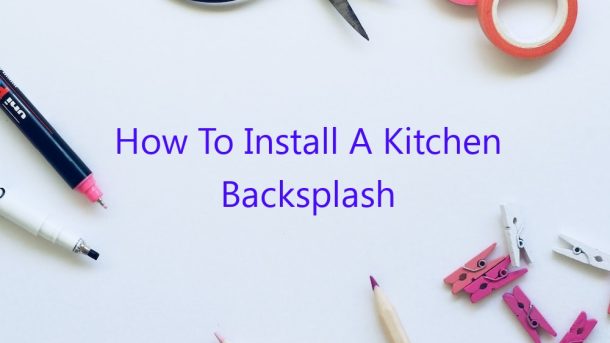Installing a kitchen backsplash is a great way to update your kitchen without spending a lot of money. A backsplash can protect your walls from spills and splatters, and it can add personality and style to your kitchen.
There are a variety of materials that you can use to install a kitchen backsplash, including tile, stone, and metal. Each material has its own advantages and disadvantages, so you will need to choose one that best suits your needs and your budget.
Tile is a popular choice for kitchen backsplashes because it is durable and affordable. There are a variety of tile styles and colors to choose from, so you can find one that matches your kitchen’s décor. Tile is also easy to install and can be DIY-ed if you are comfortable with home improvement projects.
Stone is another popular choice for kitchen backsplashes. Stone is durable and can add a touch of elegance to your kitchen. However, stone is also expensive and can be difficult to install.
Metal is a trendy choice for kitchen backsplashes. Metal is durable and easy to clean, and it comes in a variety of styles and colors. However, metal is also expensive and can be difficult to install.
Once you have chosen the material for your kitchen backsplash, you will need to decide on the design. You can find backsplash designs online or in home improvement stores. Once you have chosen a design, you will need to measure your kitchen to make sure that the backsplash will fit.
Then, you will need to remove the old backsplash and prepare the wall for the new one. This usually involves removing the old adhesive and cleaning the surface.
Next, you will need to install the backsplash. This usually involves using adhesive and/or screws to attach the backsplash to the wall.
Finally, you will need to seal the backsplash. This usually involves using a sealant or grout to fill in the seams.
Installing a kitchen backsplash is a great way to update your kitchen without spending a lot of money. There are a variety of materials that you can use to install a kitchen backsplash, including tile, stone, and metal. Each material has its own advantages and disadvantages, so you will need to choose one that best suits your needs and your budget.
Contents
What is the easiest way to install kitchen backsplash?
Installing kitchen backsplash can be a daunting task, but it does not have to be. There are a few easy ways to do it that will make the process a breeze.
The easiest way to install kitchen backsplash is to use adhesive tiles. These tiles come in a variety of colors and designs, and they are very easy to install. All you have to do is peel and stick them to the wall.
Another easy way to install kitchen backsplash is to use metal tiles. These tiles are very durable and easy to clean, and they come in a variety of colors and designs. They are also very easy to install. All you have to do is peel and stick them to the wall.
If you want to install kitchen backsplash in a hurry, then using vinyl tiles is the way to go. Vinyl tiles are very easy to install, and they come in a variety of colors and designs. All you have to do is peel and stick them to the wall.
No matter which method you choose, installing kitchen backsplash is a breeze. So, what are you waiting for? Get started today!
Can I install kitchen backsplash myself?
Installing a kitchen backsplash is a great way to update your kitchen without spending a lot of money. It can also be a DIY project, which can save you even more money. However, before you start installing your kitchen backsplash, there are a few things you need to know.
The first thing you need to do is decide what type of backsplash you want. There are a variety of materials you can choose from, including tile, stainless steel, and PVC. Once you decide on a material, you need to measure the area you want to cover. Be sure to include the height and width of the area, as well as the grout lines.
Once you have the measurements, you can start shopping for materials. Be sure to buy enough material to cover the area you measured, plus an extra two inches on each side. This will give you enough material to cut and fit around any obstacles.
Once you have the material, you can start installing the backsplash. Be sure to read the installation instructions carefully, as each material is installed differently.
If you are installing tile, you will need to mix the adhesive and spread it on the wall. Then, you can place the tiles in the adhesive and use a rubber grout float to press them into the adhesive. Be sure to wipe away any excess adhesive and grout.
If you are installing stainless steel, you will need to attach the metal to the wall with screws. Then, you can use a drill to make holes in the metal, and use a screwdriver to attach it to the wall.
If you are installing PVC, you will need to cut the PVC to the correct size and attach it to the wall with adhesive.
Once the backsplash is installed, you can finish it off by painting the grout lines. Be sure to use a sealant to protect the backsplash from water and stains.
Installing a kitchen backsplash can be a fun and easy DIY project. Just be sure to read the instructions carefully and take your time.
How do I start installing a backsplash?
Installing a backsplash is a great way to update your kitchen without a full renovation. There are many different materials and styles to choose from, so it can be a little daunting to know where to start. Here is a guide on how to get started with installing a backsplash in your kitchen.
1. Decide on the material and style of backsplash you want. There are many different materials and styles to choose from, so take your time and decide what would look best in your kitchen.
2. Measure the area where you want to install the backsplash. This is important, as you will need to know the exact size of the area to order the correct amount of material.
3. Purchase the material and tools you will need. Make sure to buy enough material, as you don’t want to have to run out in the middle of the installation. You will also need a trowel, level, spacers, and a wet saw.
4. Prep the area where you will be installing the backsplash. This includes removing any old tiles or adhesive, and cleaning the surface.
5. Install the backsplash. This can be a little tricky, so follow the instructions carefully. Make sure everything is level and spaced correctly.
6. Finish up the installation by grouting the joints between the tiles. Let the grout dry completely before using the kitchen.
Can you put backsplash directly on drywall?
You may be wondering if you can put backsplash directly on drywall. The answer is yes, you can, but there are a few things you should know before you do.
Backsplash is a great way to add some extra protection to your walls and to add some personality to your kitchen or bathroom. If you’re looking to install backsplash directly on drywall, there are a few things you need to take into consideration.
The first thing you need to do is make sure that the drywall is in good condition and is properly primed and painted. If the drywall is not in good condition, it may not be able to support the weight of the backsplash.
You also need to make sure that the drywall is properly sealed and primed. If the drywall is not sealed and primed, the backsplash may not stick to the wall and may come loose over time.
Once you’ve ensured that the drywall is in good condition and has been properly primed and sealed, you can install the backsplash. Be sure to use a level to ensure that the backsplash is installed evenly.
If you’re not comfortable installing the backsplash yourself, you can always hire a professional to do it for you.
Overall, if you’re looking for a quick and easy way to add some personality to your kitchen or bathroom, installing backsplash directly on drywall is a great option. Just be sure to take the necessary precautions to ensure that the drywall is in good condition and is properly primed and sealed.
Does backsplash go behind stove?
There is some debate as to whether or not backsplash should go behind a stove. Some people believe that it is necessary in order to protect the walls from the heat and splatters from the stove. Others believe that it is not necessary and can actually make it more difficult to clean the stove and backsplash.
There are a few things to consider when deciding whether or not to install backsplash behind your stove. One is the type of stove you have. If you have a gas stove, it is important to have backsplash behind it to protect the walls from heat and splatters. If you have an electric stove, it is not as important, but it may still be a good idea to install backsplash behind it to protect the walls from spills.
Another thing to consider is how easy it is to clean the backsplash and stove. If the backsplash is difficult to clean, it may not be worth installing it. The same is true if the stove is difficult to clean.
Ultimately, it is up to you whether or not to install backsplash behind your stove. If you are unsure, it may be a good idea to consult a professional.
How do you prep a wall for backsplash?
Preparing a wall for a backsplash is a fairly easy process that can be completed in a few simple steps. First, you will need to remove any existing wallpaper or paint from the wall. Once the surface is clean, you can then begin to measure and mark the area where the backsplash will be installed. Next, you will need to install the backer board using the appropriate adhesive and nails. Once the backer board is in place, you can then begin to install the tile. Be sure to use a level to ensure that the tiles are installed evenly. Finally, seal the tiles with a grout sealant and allow to dry.
Does backsplash tile sit on countertop?
There are a few things to consider when installing backsplash tile, including whether or not the tile sits on the countertop. Some people believe that it is necessary to put tile directly on the countertop to create a water-resistant barrier, but this is not always the case. If the countertop is made from a water-resistant material, such as granite, then the tile can sit on top of it without any problems.
If the countertop is not water-resistant, it is important to put tile between the countertop and the backsplash to prevent water damage. This can be done by installing a water-resistant membrane between the two surfaces, or by using a thinset mortar to attach the tile to the countertop. It is also important to use a sealant on the tile to prevent water damage.
Whether or not the tile sits on the countertop is largely a matter of personal preference. Some people prefer to have the tile directly on the countertop to create a more seamless look, while others prefer to have a gap between the tile and the countertop. If you are unsure whether or not the tile should sit on the countertop, it is best to consult a professional installer.




